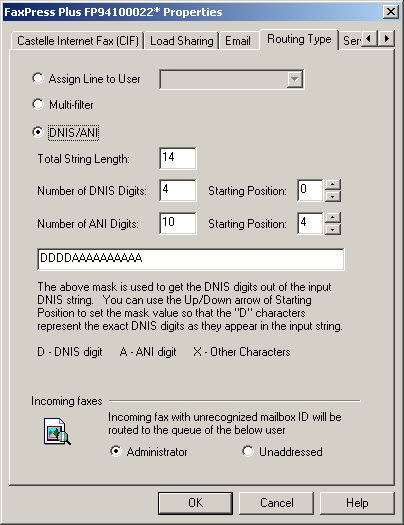The Routing Type settings allow you to configure the FaxPress Plus server for automatic inbound routing. To enable automatic routing, FaxPress Plus user mailboxes must be assigned mailbox IDs. The mailbox IDs map the user mailboxes to their corresponding fax numbers. Most mailbox IDs consist of either three or four digits, although some can be up to seven.
The Routing Type settings are only one aspect of configuring a digital Premier for automatic routing and PBX system integration. See Automatic Routing and PBX System Integration for complete instructions on configuring these and other settings required for automatic routing and PBX integration.
Use the radio buttons to set the method the FaxPress Plus server will use to distribute faxes received on the current line to user mailboxes.
Assign Line to User - Select this radio button if automatic routing is not used for the current fax line. Use the pull-down menu to select the mailbox user to which all incoming faxes are sent for manual routing, or leave the line UNADDRESSED, which allows users with Operator, Router, or Administrator privileges to route faxes from the unaddressed mailbox to any other mailbox. If UNADDRESSED is not selected, only the user whose mailbox you select will be able to manually route incoming faxes.
Multi-filter - Select this button to enable filtering based on CID and CSID caller information. This feature requires the presence of a configuration file (see Configuring the CIDRoute.cfg configuration file for CID routingand Routing Type sections below) on the FaxPress Plus server.
DNIS/ANI
Total String Length - Use this field to enter the number of digits the PBX passes in the complete string, including the mailbox ID.
Number of DNIS Digits - Use this field to enter the number of digits used in the mailbox ID. This will be either 3 or 4 digits.
Number of ANI Digits - Use this field to enter the number of ANI digits, if any, that occur in the string. ANI digits are used for Caller ID purposes in Europe.
Starting Position - Use these fields to enter the DNIS mailbox ID’s starting position in the string, i.e. whether it’s positioned at the beginning, in the middle, or at the end of the string.
Mask Value - Use this field to enter mask symbols for the entire digit string passed by your T1 line. Use D to represent the 3 or 4 digits the FaxPress Plus server will use for the Mailbox ID, and X to represent any unnecessary digits the FaxPress Plus server will strip.

Configuring the CIDRoute.cfg configuration file for CID routing
[General]Enabled=1[CID]NNN=UserName
where NNN is the caller ID information as received (e.g., 4085551212) in canonical format, and UserName is the user name that the call will be routed to (e.g., CHUCK_DILLER).
Based on incoming routing filter rules, if a match is not made the call is routed to the user UNADDRESSED.
If you are configuring the configuration file manually, you must reboot the server for the changes to take effect.
Configuring the CSIDRoute.cfg configuration file for CSID routing
[General]Enabled=1[CSID]NNN=UserName
where NNN is the caller ID information as received (e.g., 4085551212), and UserName is the user name that the call will be routed to (e.g., CHUCK_DILLER).
Based on incoming routing filter rules, if a match is not made the call is routed to the user UNADDRESSED.
If you are configuring the configuration file manually, you must reboot the server for the changes to take effect.
|
FaxPress Enterprise & Enterprise Redundant WebHelp
Last Updated: 11/1/2007
E-mail this page |
Castelle 855 Jarvis Drive, Suite 100 Morgan Hill, CA 95037 Toll-free 800.289.7555 Tel 408.852.8000 Fax 408.852.8100 |